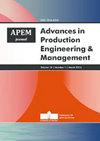高性能铝合金立铣削:不同锯齿形刃口刀具形状对切削力的影响
IF 2.8
3区 工程技术
Q2 ENGINEERING, MANUFACTURING
引用次数: 9
摘要
介绍了AlZn5.5MgCu铝合金高性能铣削的试验研究结果。使用具有不同锯齿形切削刃的立铣刀进行了试验。立铣刀有连续型、间断型和不同轮廓半径的波浪型。在DMG的DMU 100 MonoBlock加工中心上进行了测试,并对工件系统性能进行了切削力分量测量。采用应用三水平全设计试验,采用不同径向切削深度和单齿进给量fz参数进行试验。确定了不同切削刃形状下ae、fz参数与切削力分量的关系。采用连续的切削刃作为参考形状。根据试验结果,确定了分析切削刃形状的切削力分量模型。对所建立的模型和模型之间的关系进行了比较分析。研究表明,采用锯齿形切削刃的直齿立铣刀比采用连续切削刃的直齿立铣刀获得更低的切削力分量。结果还表明,对于锯齿形切削刃的立铣刀,径向切削深度ae对进给力分量Ff的影响可以忽略不计。结果表明,具有锯齿形切削刃的立铣刀应用于高性能加工,其中采用高值的ae和fz参数。此外,薄壁工件的加工可能是这些立铣刀的潜在应用,因为较低的切削力分量值降低了铣削薄壁变形的风险。©2019马里博尔大学CPE。版权所有。本文章由计算机程序翻译,如有差异,请以英文原文为准。
High-performance end milling of aluminum alloy: Influence of different serrated cutting edge tool shapes on the cutting force
The article presents the results of experimental studies in high performance milling of AlZn5.5MgCu aluminum alloy. The tests were performed with the use of end mill cutters with different serrated shapes of the cutting edge. End mills with continuous, interrupted and wavy with varied profile radius were used. The tests were conducted on a DMG’s DMU 100 MonoBlock machining center with cutting force components measurement in workpiece system capabilities. The experimental tests were carried out using varied radial depth of cut ae and feed per tooth fz parameters according to applied three‐level full design of experiment. The relationships between ae and fz parameters and cutting force components for various cutting edge shapes were determined. A continuous cutting edge was adopted as a reference shape. Based on the re‐ sults of the tests, cutting force components models for analyzed cutting edge shapes were determined. A comparative analysis between the developed models and relationships was conducted. The study proved that when adopt‐ ing end mills with serrated cutting edges, lower cutting force components are obtained, in comparison with cutters with continuous cutting edges. The results also showed that for end mills with serrated cutting edges radial depth of cut ae has a negligible influence on the feed force component Ff. The results proved, that end mills with serrated cutting edges should be used in high performance machining, where high values of ae and fz parameters are adopt‐ ed. Furthermore, machining of thin‐walled workpieces can be a potential application of these end mills, as lower values of cutting force components reduce the risk of deformation of milled thin walls. © 2019 CPE, University of Maribor. All rights reserved.
求助全文
通过发布文献求助,成功后即可免费获取论文全文。
去求助
来源期刊

Advances in Production Engineering & Management
ENGINEERING, MANUFACTURINGMATERIALS SCIENC-MATERIALS SCIENCE, MULTIDISCIPLINARY
CiteScore
5.90
自引率
22.20%
发文量
19
期刊介绍:
Advances in Production Engineering & Management (APEM journal) is an interdisciplinary international academic journal published quarterly. The main goal of the APEM journal is to present original, high quality, theoretical and application-oriented research developments in all areas of production engineering and production management to a broad audience of academics and practitioners. In order to bridge the gap between theory and practice, applications based on advanced theory and case studies are particularly welcome. For theoretical papers, their originality and research contributions are the main factors in the evaluation process. General approaches, formalisms, algorithms or techniques should be illustrated with significant applications that demonstrate their applicability to real-world problems. Please note the APEM journal is not intended especially for studying problems in the finance, economics, business, and bank sectors even though the methodology in the paper is quality/project management oriented. Therefore, the papers should include a substantial level of engineering issues in the field of manufacturing engineering.
 求助内容:
求助内容: 应助结果提醒方式:
应助结果提醒方式:


